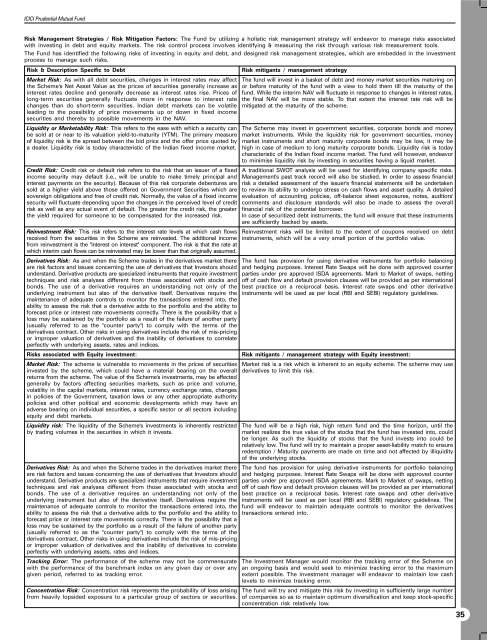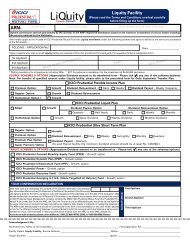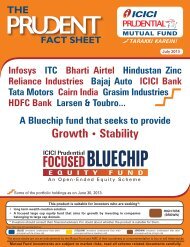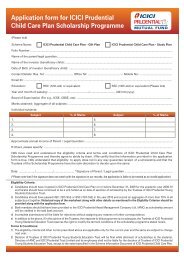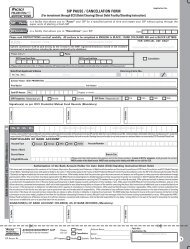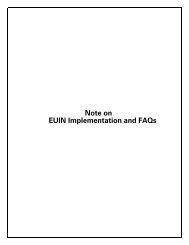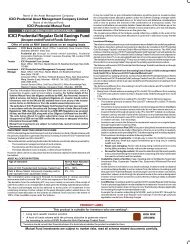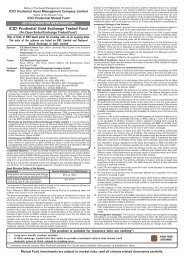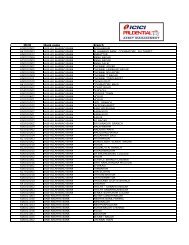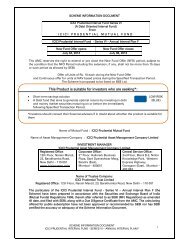Key Information Memorandum & Common Application Form Key ...
Key Information Memorandum & Common Application Form Key ...
Key Information Memorandum & Common Application Form Key ...
You also want an ePaper? Increase the reach of your titles
YUMPU automatically turns print PDFs into web optimized ePapers that Google loves.
ICICI Prudential Mutual Fund<br />
Risk Management Strategies / Risk Mitigation Factors: The Fund by utilizing a holistic risk management strategy will endeavor to manage risks associated<br />
with investing in debt and equity markets. The risk control process involves identifying & measuring the risk through various risk measurement tools.<br />
The Fund has identified the following risks of investing in equity and debt, and designed risk management strategies, which are embedded in the investment<br />
process to manage such risks.<br />
Risk & Description Specific to Debt<br />
Risk mitigants / management strategy<br />
Market Risk: As with all debt securities, changes in interest rates may affect<br />
the Scheme's Net Asset Value as the prices of securities generally increase as<br />
interest rates decline and generally decrease as interest rates rise. Prices of<br />
long-term securities generally fluctuate more in response to interest rate<br />
changes than do short-term securities. Indian debt markets can be volatile<br />
leading to the possibility of price movements up or down in fixed income<br />
securities and thereby to possible movements in the NAV.<br />
Liquidity or Marketability Risk: This refers to the ease with which a security can<br />
be sold at or near to its valuation yield-to-maturity (YTM). The primary measure<br />
of liquidity risk is the spread between the bid price and the offer price quoted by<br />
a dealer. Liquidity risk is today characteristic of the Indian fixed income market.<br />
Credit Risk: Credit risk or default risk refers to the risk that an issuer of a fixed<br />
income security may default (i.e., will be unable to make timely principal and<br />
interest payments on the security). Because of this risk corporate debentures are<br />
sold at a higher yield above those offered on Government Securities which are<br />
sovereign obligations and free of credit risk. Normally, the value of a fixed income<br />
security will fluctuate depending upon the changes in the perceived level of credit<br />
risk as well as any actual event of default. The greater the credit risk, the greater<br />
the yield required for someone to be compensated for the increased risk.<br />
Reinvestment Risk: This risk refers to the interest rate levels at which cash flows<br />
received from the securities in the Scheme are reinvested. The additional income<br />
from reinvestment is the "interest on interest" component. The risk is that the rate at<br />
which interim cash flows can be reinvested may be lower than that originally assumed.<br />
Derivatives Risk: As and when the Scheme trades in the derivatives market there<br />
are risk factors and issues concerning the use of derivatives that Investors should<br />
understand. Derivative products are specialized instruments that require investment<br />
techniques and risk analyses different from those associated with stocks and<br />
bonds. The use of a derivative requires an understanding not only of the<br />
underlying instrument but also of the derivative itself. Derivatives require the<br />
maintenance of adequate controls to monitor the transactions entered into, the<br />
ability to assess the risk that a derivative adds to the portfolio and the ability to<br />
forecast price or interest rate movements correctly. There is the possibility that a<br />
loss may be sustained by the portfolio as a result of the failure of another party<br />
(usually referred to as the "counter party") to comply with the terms of the<br />
derivatives contract. Other risks in using derivatives include the risk of mis-pricing<br />
or improper valuation of derivatives and the inability of derivatives to correlate<br />
perfectly with underlying assets, rates and indices.<br />
Risks associated with Equity investment:<br />
Market Risk: The scheme is vulnerable to movements in the prices of securities<br />
invested by the scheme, which could have a material bearing on the overall<br />
returns from the scheme. The value of the Scheme's investments, may be affected<br />
generally by factors affecting securities markets, such as price and volume,<br />
volatility in the capital markets, interest rates, currency exchange rates, changes<br />
in policies of the Government, taxation laws or any other appropriate authority<br />
policies and other political and economic developments which may have an<br />
adverse bearing on individual securities, a specific sector or all sectors including<br />
equity and debt markets.<br />
Liquidity risk: The liquidity of the Scheme's investments is inherently restricted<br />
by trading volumes in the securities in which it invests.<br />
Derivatives Risk: As and when the Scheme trades in the derivatives market there<br />
are risk factors and issues concerning the use of derivatives that Investors should<br />
understand. Derivative products are specialized instruments that require investment<br />
techniques and risk analyses different from those associated with stocks and<br />
bonds. The use of a derivative requires an understanding not only of the<br />
underlying instrument but also of the derivative itself. Derivatives require the<br />
maintenance of adequate controls to monitor the transactions entered into, the<br />
ability to assess the risk that a derivative adds to the portfolio and the ability to<br />
forecast price or interest rate movements correctly. There is the possibility that a<br />
loss may be sustained by the portfolio as a result of the failure of another party<br />
(usually referred to as the "counter party") to comply with the terms of the<br />
derivatives contract. Other risks in using derivatives include the risk of mis-pricing<br />
or improper valuation of derivatives and the inability of derivatives to correlate<br />
perfectly with underlying assets, rates and indices.<br />
Tracking Error: The performance of the scheme may not be commensurate<br />
with the performance of the benchmark index on any given day or over any<br />
given period, referred to as tracking error.<br />
Concentration Risk: Concentration risk represents the probability of loss arising<br />
from heavily lopsided exposure to a particular group of sectors or securities.<br />
The fund will invest in a basket of debt and money market securities maturing on<br />
or before maturity of the fund with a view to hold them till the maturity of the<br />
fund. While the interim NAV will fluctuate in response to changes in interest rates,<br />
the final NAV will be more stable. To that extent the interest rate risk will be<br />
mitigated at the maturity of the scheme.<br />
The Scheme may invest in government securities, corporate bonds and money<br />
market instruments. While the liquidity risk for government securities, money<br />
market instruments and short maturity corporate bonds may be low, it may be<br />
high in case of medium to long maturity corporate bonds. Liquidity risk is today<br />
characteristic of the Indian fixed income market. The fund will however, endeavor<br />
to minimise liquidity risk by investing in securities having a liquid market.<br />
A traditional SWOT analysis will be used for identifying company specific risks.<br />
Management's past track record will also be studied. In order to assess financial<br />
risk a detailed assessment of the issuer's financial statements will be undertaken<br />
to review its ability to undergo stress on cash flows and asset quality. A detailed<br />
evaluation of accounting policies, off-balance sheet exposures, notes, auditors'<br />
comments and disclosure standards will also be made to assess the overall<br />
financial risk of the potential borrower.<br />
In case of securitized debt instruments, the fund will ensure that these instruments<br />
are sufficiently backed by assets.<br />
Reinvestment risks will be limited to the extent of coupons received on debt<br />
instruments, which will be a very small portion of the portfolio value.<br />
The fund has provision for using derivative instruments for portfolio balancing<br />
and hedging purposes. Interest Rate Swaps will be done with approved counter<br />
parties under pre approved ISDA agreements. Mark to Market of swaps, netting<br />
off of cash flow and default provision clauses will be provided as per international<br />
best practice on a reciprocal basis. Interest rate swaps and other derivative<br />
instruments will be used as per local (RBI and SEBI) regulatory guidelines.<br />
Risk mitigants / management strategy with Equity investment:<br />
Market risk is a risk which is inherent to an equity scheme. The scheme may use<br />
derivatives to limit this risk.<br />
The fund will be a high risk, high return fund and the time horizon, until the<br />
market realizes the true value of the stocks that the fund has invested into, could<br />
be longer. As such the liquidity of stocks that the fund invests into could be<br />
relatively low. The fund will try to maintain a proper asset-liability match to ensure<br />
redemption / Maturity payments are made on time and not affected by illiquidity<br />
of the underlying stocks.<br />
The fund has provision for using derivative instruments for portfolio balancing<br />
and hedging purposes. Interest Rate Swaps will be done with approved counter<br />
parties under pre approved ISDA agreements. Mark to Market of swaps, netting<br />
off of cash flow and default provision clauses will be provided as per international<br />
best practice on a reciprocal basis. Interest rate swaps and other derivative<br />
instruments will be used as per local (RBI and SEBI) regulatory guidelines. The<br />
fund will endeavor to maintain adequate controls to monitor the derivatives<br />
transactions entered into.<br />
The Investment Manager would monitor the tracking error of the Scheme on<br />
an ongoing basis and would seek to minimize tracking error to the maximum<br />
extent possible. The investment manager will endeavor to maintain low cash<br />
levels to minimize tracking error.<br />
The fund will try and mitigate this risk by investing in sufficiently large number<br />
of companies so as to maintain optimum diversification and keep stock-specific<br />
concentration risk relatively low.<br />
35


